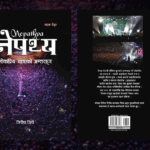With the local level elections 2022 culminating on 13 May, it marked the continuity of a process in which almost 18 million Nepali voters were given the opportunity to vote for a candidate of their choice. Such a sight is reassuring and provides an optimistic outlook for Nepal. Especially considering the history of the political landscape in the country, where elections were not always conducted timely, and its significance was hardly communicated to the general public.
Context of local governance and voting in Nepal
Local governance in Nepal, which is integrated into politics, dates back to the third century when there was a Panchayat system. Panchayats were a party-less system that was institutionalized to provide a semblance of decentralization, however, the Nepali people faced repeated changes in the government and the withdrawal of local governments time and again. The People’s Movement of the 1990s brought about a new freedom in the economy, but the interparty dispute that led to political instability and factionalism, did not decline. Democracy was restored in 1991; a multi-party government was set up; periodic elections were also held in 1992 and 1997. Later, in 1999, the Local Self-Governance Act (LSGA) was enacted that provided more power and authority to local governments and ensured that women gained higher representation in the local elections.
However, due to the Maoist insurgency at the time, the continuity of the elections was perpetually disrupted. The agenda, then, was mostly to resolve the conflicts and negotiate with the opposition groups. When the elections for the Constituent Assembly were held in 2008 and 2013, people’s representatives were brought to the forefront, but it lacked true representation as citizens were fed with unmet political commitments, repeated party conflicts and changes, centralized governance, and a lack of accountability.
While Article 84 (5) of the Constitution of Nepal states that every citizen of Nepal completing 18 years of age has the right to vote, Nepali citizens had not been able to exercise this right actively as there was a long gap from 1997, since Nepali citizens had last voted. Against this backdrop, a variety of articles and opinion pieces were published at the time, which expressed that Nepal was practicing democracy without elections. These media pieces highlighted that Nepal witnessed frequent changes in its government that functioned under different constitutional frameworks, suggesting the fragility of the Nepali economy.
Later, after the onset of federalization through a new constitution on 16 September 2015, citizens got an opportunity to vote for their representatives in 2017. However, the political party alliance is strong in the case of Nepal. Due to this, despite voting being a right and the fundamental foundation of democracy, voters are simply scared to cast their ballots due to a fear of reprisals by opposition political parties. The rural areas of Nepal also face a menacing influence of money from political parties instead of getting a chance to engage with or evaluate the manifestos of elected bodies.
Perception of citizens toward local governance and voting
Citizens have often seen a former advocate of civil rights transform into a dectractor and when in power, change into a corrupt leader. As a result, citizen participation, responsibility, and accountability at the local level are most needed but underserved.
One of the major reasons behind this is the unwillingness among the citizens to partake in state functions due to the widespread unawareness about the significance of their participation and fear of the ways to participate. For instance, since the onset of federalization in Nepal in 2015, nearly 7% of the total revenue of the federal government is allocated to the provincial governments and another 7% to the local governments, indicating how local governments have the power and authority to work on the development and economic well-being of their respective sectors and its citizens.
Keeping these factors and historic developments in mind, it is essential to educate citizens about the foundation of democracy. It will help them understand that they have the power to regulate change and achieve all the elements of development they desire; it can only be possible through free, fair, and timely elections. Local elections are centered around the citizens. Citizens have the power to choose a capable leader who can take on duties and raise the standard of living in their communities by simply voting in elections and casting ballots for local bodies and their deputies.
Significance of local governance and voting for local governments
Undoubtedly, the operational scenario in Nepal across the three tiers of the government has witnessed a transformational change over the past decade. As things stand, all the tiers today are going through transition, six years post the transformation to a federal state, powered by the continuing cynicism; and at the heart of these transitions lie political instability and inconsistency. However, the last local election of 2017, with 74.16% voter turnout, was a sign of victory as it stirred the country towards the path of federalism. This year’s local election that concluded on 13 May 2022, furthered this move towards federalism, demonstrating the recognition of a definite need for a more responsible government, where citizens are also willing to do their part.
Having said this, the voter turnout has reportedly decreased this time around. Kathmandu, the biggest metropolitan city of Nepal with around 300,000 eligible voters, witnessed only around 64% turnout as per the Election Commission of Nepal. The most pertinent reasons behind this are the lack of communication and awareness about the process and urgency of voter registration, lack of accountability from the large Non-Resident Nepali diaspora as well as the anticipation of clashes and violence in voting centers. However, the significance of local elections must be communicated well as a pertinent drive from both the private and public bodies.
Citizens need to concur with the responsibility from their end and realize that elections act as backbone to support the economy. For this, voters have to be encouraged through discussions that are centered around various government-related themes and pressing issues of their locality. There are different issues plaguing the cities of Nepal such as spillover of rivers, dumping of wastes in the streets, defunct street lamps, encroachment in open spaces, poor sewerage system, etc.
Considering this, citizens have to demand for changes and accountability from the government. Only then can an institutional change occur.
For example, one of such issues at Basundhara in Kathmandu is the inundation by streams in the rainy season and for years on end, the citizens of the concerned area have been demanding a solution to the problem. As old as such issue is at Basundhara, and the rest of the wards in Kathmandu, voters have also always cast their votes based on their personal relationship with the party, thus resulting in no solution to the problem. However, since this time around there are more youth voters who are educated and understand that agendas and plans to address local needs are more important than maintaining decade-long alliance toward political parties, the zeal with which votes have been cast are different.
Early results from the May 2022 elections reveal that when given the power to educated and passionate youth voters, they tend to align with a candidate who is motivated and presents their ideas and plans that are in line with the needs of the citizens. As such, there are lots of hopes riding on young Mayoral and Deputy Mayoral candidates who are posing a real challenge for political parties and prompting them towards introspection throughout the country. It almost seems like the country is ready for a change. Only time will tell how things will unfold, but it is important to establish the significance of elections and the value of targeted communication in spreading awareness.
Stability, in the case of Nepal is a practice that necessitates an institutional change on the part of bureaucrats, civil society members, and Nepali citizens around the world. The first step toward this is communicated and educating citizens about the whys and the hows. If properly done, there will be a surge in voter turnout in future elections, furthering accountability and responsibility.
Nasala Maharjan is a Bachelor's in Business Administration (BBA Honors) graduate from Kathmandu University with a major in Finance. She is mostly interested in researching and writing about economic development and contemporary issues in Nepal. She joined Nepal Economic Forum (NEF) as a Research Fellow in 2019 and is currently a beed at beed management.





